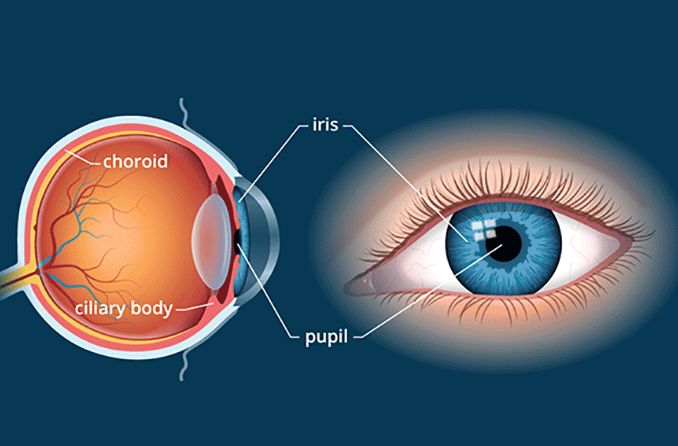What is the choroid?
The choroid is the middle layer of tissue in the wall of the eye. It’s found between the sclera (the whites of the eyes) and the retina (the light-sensitive tissue in the back of the eye).
This thin layer of tissue is made up almost entirely of blood vessels. These blood vessels supply oxygen and nutrients to the outer part of the retina. In short, the choroid is the life source that keeps the retina healthy and functioning.
Choroid anatomy
The choroid is part of the uvea, which also consists of the iris and the ciliary body. The iris and ciliary body are located in the front of the eye and work together to dilate and constrict the pupils.
The choroid layer begins in the peripheral edges of the eyeball and lines the entire back of it, sandwiched between the sclera and the retina. The thickness of the choroid varies depending on what part of the eye it’s lining. For example, it’s the thickest in the back of the eye (approximately 0.2 mm) and narrows to approximately 0.1mm as it gets to the peripheral part of the eyeball.
There are four different layers of the choroid:
Bruch’s membrane – Thin layer of tissue located on the innermost part of the choroid.
Choriocapillaris – Layer made up of capillaries (tiny blood vessels that connect arteries to veins).
Sattler’s layer – Layer of medium blood vessels.
Haller’s layer – Outermost layer of the choroid that contains large blood vessels.
Choroid function
The eyes and clear vision depend on sufficient blood supply in order to function. Choroidal circulation accounts for 85% of blood flow within the eye, making it a vital structure to the function of your eyes.
Other important functions of the choroid include:
Providing nutrients for the retina, macula and optic nerve.
Regulating the temperature of the retina.
Helping control pressure within the eye.
Absorbing light and limiting reflections within the eye that could harm vision. This part of the choroid is what causes “red eyes” when a photograph is taken using the flash unit of a camera.
Conditions that may affect the choroid
Choroid eye conditions can develop sporadically, genetically or as a result of eye trauma. Each of the following conditions can be evaluated by an eye doctor, who will then determine and prescribe proper treatment:
Choroidal detachment – A “ serous choroidal detachment ” occurs when fluid fills between the sclera and choroid. It can occur due to injury, medications or some medical conditions, but it most typically occurs due to low pressure after eye surgery.
Hemorrhagic choroidal detachment – A “ hemorrhagic choroidal detachment ” occurs when blood fills the space between the sclera and choroid, such as when a blood vessel bursts. It is associated with high pressure in the eyes and can occur during surgery. It is usually more painful than a serous detachment.
Choroidal rupture – A tear in the choroid, Bruch’s membrane and the retinal pigment epithelium (RPE) that result from an eye injury.
Choroid plexus papilloma – Rare, benign brain tumor that develops in the choroid plexus (tissue that makes cerebrospinal fluid).
Chorioretinitis – Inflammation of the choroid caused by infection or an autoimmune disease.
Choroideremia – A hereditary, progressive deterioration of the choroid; this condition primarily affects men.
Importance of routine eye exams
While the choroid is an important part of the eye, it’s difficult to identify any problems with it unless you have an eye exam. During a fundoscopic eye exam, your eye doctor will use a tool that allows them to view the back of the eye, where the choroid is located.
Using this method, they can determine the health of the choroid and prescribe treatment if they detect a problem.
READ MORE: Retinopathy

